The SNES days are getting pretty close. I have a couple NES games left including Bad News Baseball,Base Wars and the Baseball Stars series to get through first. You wouldn't be referring to Ken Griffey Jr games are you? ;)
jbn566's forum posts
@Claude: I might put a poll out there on which baseball series people played in the 80's. Either you were a Bases Loaded fan or an R.B.I. fan it seems
@Slag: Thanks for your comments regarding my baseball blog series.
This is a series of blogs based on my own personal game collection. I will attempt to go through them in a chronological order according to their release date. I will also attempt to play then on their original platform using the original controllers the game was designed for. If I am unable to get the system or the game working then I will use PC emulation or another platform emulation like the Intellivision Lives! game for the gamecube
Previous entries
| 8. Intellivision's World Championship Baseball (1983) 9. Sega Master System's Great Baseball (1987) 10. Nintendo's Bases Loaded (1987) 11. Nintendo's R.B.I Baseball (1988) |
Major League Baseball for Nintendo Entertainment System (1988)
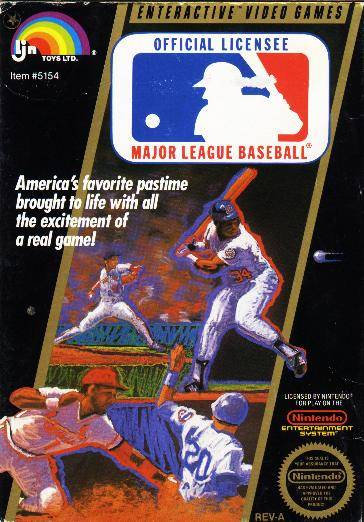
Video game players who had a Nintendo Entertainment System were lucky enough to have three baseball games released back to back to back in 1987-1988. The first was Bases Loaded, which didn't contain any MLB teams nor MLB players’ names or stats. The second was the ever popular R.B.I Baseball game that included MLB player names and stats but no MLB teams. Last but not least is Major League Baseball, as the name implies, officially licensed by the MLB. This is the first game to include actual MLB teams and players stats. MLB player's name is trademarked by MLBPA and as a result the player's names are not included and every player is referenced by only their number. Does the lack of the players name hurt the gameplay? Next up to the plate is #12.
Graphics
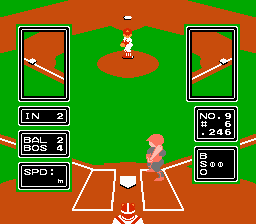
If you quickly glance at the screenshot you might think it was RBI Baseball. The two games look really similar; the impact of RBI Baseball is starting to shape up. The pitcher/batter duel contains a lot of popup overlays like a windows application. The inning count is in a separate box, the score in another. One info box that always appears is the speed of the pitch but the speed disappears as soon as you select your next pitch. In general the text is always readable; it always is on all NES games that use the default font. One of the aspects of the graphics that simply gets the job done is the menu system. In this game you have complete control of the lineup and the menu system for this feature is ugly and only contains text on a solid blue background.
Field
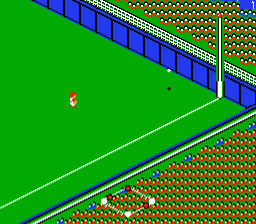
We are still in the era of video games where things look cartoony. I say that as a positive thing; The platforms in the 80's just can't display textures and as such the graphics such as a baseball playing field use solid colors. The dirt is a solid brown and the grass is a solid green. The field has a nice sense of depth, the outfield wall has height and the ball bounces of it fairly correctly, the foul lines are tall and extend past the outfield wall. The scoreboard compared to the other games released the same year is really dull and don't include much of anything besides the score.
Players
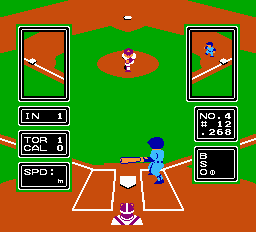
The rendering of the players are very much like RBI Baseball game. The batters have helmets and the batting stances vary like Bases Loaded. The uniforms have accurate colors schemes according to the MLB teams' official colors. The first and third base cameras are not as zoomed in as the batter and so the detail of the base runners are reduced. The back of the catcher is also displayed and the lines of the catcher’s mask are correctly displayed as well as the straps of his pads.
Fans
Another baseball game, another game where the fans are displayed as ugly wallpaper. If you have been following these blogs you might remember how happy I was to see crowds in the game, Now that I have seen crowds I am getting tired of lack of innovation. Below screenshots may help prove my complaint; Can anyone honestly say the crowds in Major League Baseball are years better then Nintendo's first Baseball game?
| NES Baseball (1983) | Sega Great Baseball (1987) | NES RBI Baseball (1988) | NES Major League Baseball (1988) |
|---|---|---|---|
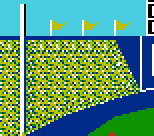 |  | 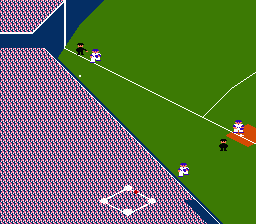 |  |
Home Run Celebrations
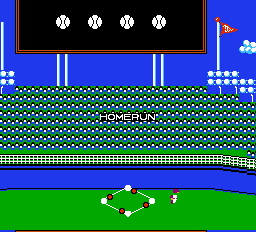
This has to be the most boring celebration on the NES so far. The camera doesn't move from where the ball landed in the stands. The crowd roars and the word 'Home Run' appears in the center of the screen as the score is also popped up as each base runner touches home plate. If you manage to hit the home run near the scoreboard you can notice the scoreboard displays just 4 large baseballs evenly spaced.
Camera/Screens
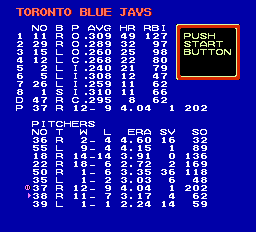
The camera displays the field at a very nice angle that provides the user with a great sense of depth. As typical with baseball games of this era fielding is difficult because the camera focuses on the ball and not the fielder so a lot of times you have to guess where the fielder is related to the ball because the fielder is out of view. One of the biggest issues I have with the game is the fact that for some reason, this game has a load screen when it has to change cameras and screens. The load screen gets in the way of the game play and delays what is already a slow sport. It is really noticeable when you hit the ball and have to wait to see the direction of where you hit it.
I also can't leave without mentioning the ugly menu system when controlling the lineup and manager choices. The entire screen from top to bottom, left to right is white text on a blue background. Being a windows user, I usually refer to this as the blue screen of death. I greatly appreciated the ability to manage my own line up. It truly is a great innovation in terms of baseball video games but I am really looking forward to a developer taking this to the next level and making the menu system easier to use and easier on the eye and less like I am reviewing a spreadsheet for a school project.
Sound
There is no background music besides the radio static noise that I guess is supposed to be the sound of the crowd. The game does include some classic ballpark jingles and chants such as the 'Charge'. Besides that, nothing really special.
Gameplay - Modes
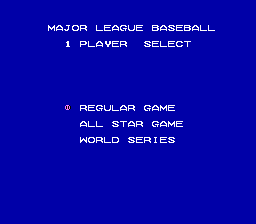
We have three modes for 1 player and a single 2 player mode
- Regular Game - single nine inning baseball game. you are able to select the team
- All - Star Game - single nine inning game but able to build your line up from all teams
- World Series - Best of 7 nine inning games.
Gameplay - Defense
I do have to say the game physics take a while to accept and learn. One aspect of the physics that seem different from the 11 other baseball games I have played this month is that the ball doesn't roll as one would expect it to. After 1 or 2 bounces in the grass it simply stops as if the outfield turned into green glue paper. I wouldn't bash the developers for having inaccurate physics; it is just different and takes a little learning curve to fielding and running around to collect the ball. Another aspect of the defense that seems odd is I couldn't figure out how to tag a base to get the force out. It seemed the game didn't let me pick up the ball and run to the base ahead of the runner; either I had to tag the actual runner or throw it the base. This affected me more the green glue outfield because I had to change the way I normally play the game during various situations. For example If there was a runner on third and my opponent hits a line drive to first base, I would have the first baseman pick up the ball and move to the base for the force out. But here if the first baseman collects the ball there is nobody to on the base to throw to so I have to run down and tag the runner myself which is just enough time for the runner on third to score. Maybe I totally missed something in the instructions but I tried everything. The pitcher can't move on the mound and the throw animations are at times not smooth, sometimes the ball changes speeds in mid-air
Gameplay - Offense
The batting isn't bad, the inability to move the batter left and right and only up and down is a little different than previous games but I didn't feel I missed that freedom. To perform a bunt just a tap of the A button, to swing for the fence hold down the A button. This tapping vs holding down the button is start of maybe some analog control of the swing and a step in the right direction. Performing a pitchhitter change is nice and easy, the game provides enough stats to make you feel like you can a sound decision like a baseball manager would.
Rules of Baseball
Ability to manage your lineup is all I need to hear to know that this game adheres to standard rules of baseball. This is the first baseball game that gives the power of forming a lineup in the player's hand. When you select your lineup, you cycle through general positions such as infield,outfield,catcher and pitcher. The game forces you to have the correct number of infields and outfielders but doesn't list the actual position such as first baseman, shortstop, left field...etc
The physics in the game does hurt when dealing with how baseball is played; Baseballs are round and suppose to roll in the outfield. Because this game is licensed by MLB, it does a touch of respect in terms of how baseball is played.
The stats included for each batter are AVG,HR,RBI,as well as left/right handed.
Video Game Innovations
- MLB team names
- MLB player stats
- Ballpark jingles
This is a series of blogs based on my own personal game collection. I will attempt to go through them in a chronological order according to their release date. I will also attempt to play then on their original platform using the original controllers the game was designed for. If I am unable to get the system or the game working then I will use PC emulation or another platform emulation like the Intellivision Lives! game for the gamecube
Previous entries
| 7. Nintendo's Baseball (1983) 8. Intellivision's World Championship Baseball (1983) 9. Sega Master System's Great Baseball (1987) 10. Nintendo's Bases Loaded (1987) |
R.B.I. Baseball for Nintendo Entertainment System (1988)

The late 80's brought about a new era of baseball video games. The first entry of popular baseball game franchises will make there start during this time. Nintendo was taking over the family TV and baseball was quickly becoming the most popular sport video game. Last entry of this series introduced the Bases Loaded; here we introduce the popular R.B.I baseball series. From here on out Bases Loaded and R.B.I will continue to produce sequels and compete for the market share. R.B.I. Baseball included many new innovations but they all dwarf in comparison to their greatest innovation which was including actual MLB player names and their stats in the game. No game before could I play as my favorite real life ball player and after R.B.I Baseball not sure if I can go back to generic players. Keep in mind however that they only had a contract with the players association and not MLB so the teams were still generic and team names only consisted of the city
Graphics
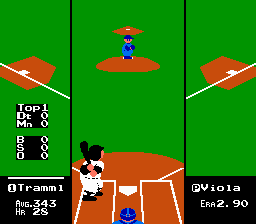
One general rule to keep in mind while playing R.B.I. baseball is the presentation style is cartoony and less realism. Bases Loaded attempted to present the players, field as real as possible, R.B.I Baseball simply doesn't. All the players are short and fat and the uniforms are very colorful and bright, The speed of the game is a lot faster than how baseball is typically played. Overall there is a general 'arcade' style to the graphics. The game splits the pitcher/batter duel into 3 vertical cameras. On the left we see a close up of third base, the middle is the batter and pitcher as well as 2nd base in the distance and on the right is 1st base. With game time information easily readable to for the user. The current batter's stats are always displayed as well as the pitcher's information. If you are a fan of baseball stats than you will fall in love with this game; All the game stats are very easy to read and use the correct baseball abbreviations.
Players
Even though this is the first game to include real life MLB players, each batter, base runner and pitcher contains unique stats that affect the gameplay, graphic wise they sort of dropped the ball. All the batters look the same. They are all white with a little belly fat to them. Their bats are a little cartoony, and wide, the width of their helmets. The base running animation is pretty smooth and I enjoy the way the base runners are shown when they get ready to steal. It appears as though every play ends up being a slide into the game, which is a little odd but still somewhat enjoyable to watch as you feel the play was close. The batter can move about inside the batter's box as well as the pitcher can move about on the mound.
Field
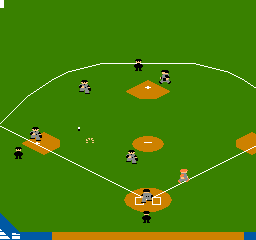
The pitcher/batter duel display shows a really detailed close up of all the bases and is easy on the eye. The infield however is less detailed. I can only assume the stadium is in a dome because there is no infield dirt along the base paths only around the bases itself. A lot of Astroturf fields during the 80's had their fields constructed this way but for a very game it seems a little weak. Once again we presented inside a stadium, which I think it is safe to say par for the course now in baseball video game history. There is no way a game can come out that doesn't include stadium graphics such as outfield walls, flags, and scoreboard and take itself seriously. There are umpires positioned on the field which is increasing become standard for baseball games as well and always nice to see. One of the field innovations this game includes is the stadium lights. The games are all played at night and as such along the stadium walls you can see the lights. There is no lighting effects but rather just white circles grouped together to represent light bulbs
Fans

For the love of all things that are video games, when can we actually see individuals in the crowd or at least see a crowd that looks like it contains actual humans and not some wallpaper pattern that can be seen in my grandparents living room. The crowd in this game is under par. I am not sure why games continue to use this method of displaying a crowd, maybe the system just can't handle animations of that size?
Home Run Celebrations
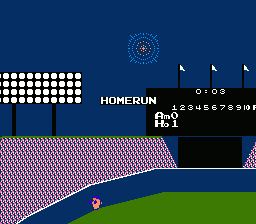
Bases Loaded still has the best celebrations in my book but this game isn't bad. It takes a page from Super Mario Bros and displays nice fireworks celebration. Because the games are played at night why fireworks shouldn’t been shown right? Real baseball should adopt this feature. Like Super Mario Bros, the numbers of fireworks are not random; 5 fireworks for solo home runs, 6 for two runs, 7 for three runs and 8 bursts of colorful explosions for a grand slam. The number of fireworks makes this game of the firsts to do something different for grand slams vs home runs.
Camera/Screens

As much as the popular behind the pitcher view has become in the late 80's, this game improved the tried and true behind the batter view. What makes this game unique and the game's most visual unique feature is the screen is split into three separate screens. The base runners are not displayed in a picture-in-picture view or a graphical icons representation. This game has dedicated cameras for each base and during the pitch you are presented with all three camera views. It is not as confusing or busy as it may seem and nice attempt to present the gamer with the entire information one needs to manage and play a game of baseball. When the ball is in play it goes to a one camera system with a graphical representation of the base paths to determine the location of the base runners at all times.
Sound
This is the second baseball game that has background music, the first being Bases Loaded. While the bases loaded background wasn't memorable, the background music for this game is almost unbearable. It included looping over the same 5-8 note melody and was very 'beeb-boop' The sound effects for this game wasn't that great either and there was no umpire voice calling the plays. This is the biggest area of improvement the developers should make for RBI Baseball 2.
Gameplay - Modes
RBI Baseball provides the user with three different modes of play
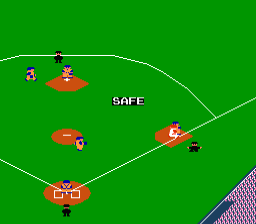
- 1 player - 8 game season, attempt to beat all 8 teams
- 2 player - 7 game series.
- watch - you can decide to sit back, put the controller down and watch two CPU players compete. While this is new to baseball video game, it is hard for me to call this a gameplay mode when you literally do nothing but watch.
Gameplay - Defense
We are at our 11th entry into this series and as such the gameplay on the defense and offense really hasn't changed. To field the ball you control the person closest to the ball. I found catching a pop fly a little challenging than what it should be. It was hard for me to determine where the ball is going to drop and I noticed myself focusing on just the shadow of the ball. The ball itself does increase in size the higher it is but when the ball is so high it is out of view you have no idea if it is coming down or still going up. It might be improved if the size of the ball's shadow increased as well. Also I feel the pitching is short and fast, I can easily pitch over 100 mph fastballs.
Gameplay - Offense
Nothing too out of control on the offensive side of the ball. I am able to move the batter around the batter's box as well as control the speed of the bat and perform timely bunts. You can take control of any base runners as well. Maybe it is me being confused with all the baseball games I have been playing but I found it hard to bring a base runner back to their starting base. I had alto of outfield popflys turned into double plays against me because the CPU auto moves the runners halfway. One side thing I did notice is when you strike out, your batter gets pretty upset and cries. Is this little league?
Rules of Baseball
I mentioned a couple entries ago that the direction these games are going, there appears to be different sub genres. Arcade baseball games and simulation. RBI Baseball would fall in the arcade style in terms of gameplay but includes enough stats and strategy that it can viewed as a baseball sim. There is a mercy rule for the game to make the games move along faster. All the players have increased number of stats associated with them and the stats help setup matchups. There are players that are fast, players that hit the long ball more than others; as such you have to manage your game a little more closely like a baseball sim. The stats are real and taken from MLB 1986, 1987 seasons and the teams you can select are the division winners during those seasons as well.
There is no major misstep in the general rules of baseball and because of this; RBI baseball is a real solid baseball game.
Video Game Innovations
- Real MLB player names,numbers and stats
- Night games
- Baseball helmets for batters
- Mercy Rule ( up by 10 runs)
- Watch mode
- Multiple Cameras of equal size
- Stadium lights
- Grand Slam animation different than Home Run
- Seams of the baseball shown
This is a series of blogs based on my own personal game collection. I will attempt to go through them in a chronological order according to their release date. I will also attempt to play then on their original platform using the original controllers the game was designed for. If I am unable to get the system or the game working then I will use PC emulation or another platform emulation like the Intellivision Lives! game for the gamecube
Previous entries
| 5. Microvision's Baseball (1980) 6. Atari 2600's RealSports Baseball (1982) 7. Nintendo's Baseball (1983) 8. Intellivision's World Championship Baseball (1983) 9. Sega Master System's Great Baseball (1987) |
Bases Loaded for Nintendo Entertainment System (1987)
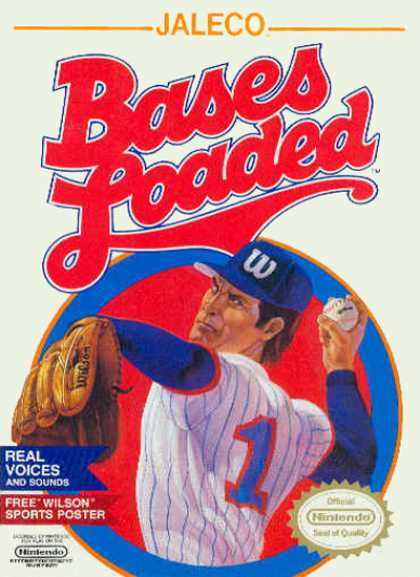
If I had to do this list based on which baseball games I enjoyed playing in my youth, Bases Loaded for the NES would be the game. I fell in love with this game as a kid and I remember endless hours in front of the TV playing this game. I used to keep a notepad next to my NES just for games like this. This game you can play a whole 80 game season and after each game you are presented with a password to save your progress. This is before internet so my notepad filled with passwords became the most important sheets of paper ever to exist. I have been looking forward to going back and playing this game ever since I decided to start this blog. I wasn't the only one playing this game at the time, a couple years later a sequel was released and at which time became a game franchise across multiple platforms. This is one of the first baseball games to accomplish this feat. Baseball games up this point were one and done. Let's see how the Bases Loaded franchise started.
Graphics
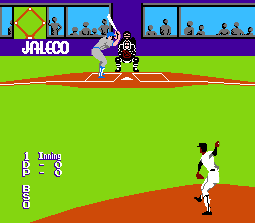
Sega's Great Baseball and Nintendo's Bases Loaded were released within months of each other in Japan. Because of these close release dates it is hard to determine which game established the infamous behind the pitcher camera view during the pitcher/batter duel. To this day when you read reviews of the game people either enjoy this view or don't, for the record I enjoy it. I find that I can see balls and strikes easier than what we have had in past games which were from the top down perspective. Not only was this view enjoyable to play in but they included simple touches to addma nice realism to the experience as if you are watching the game on TV. Like Great Baseball, they included a picture-in-picture bird's eye view of the infield so you can see where the bases runners are currently positioned. Unlike Great Baseball, it was better positioned and didn't float in the air and get in the way of the action. It was positioned along the backstop and part of the wall. The text is also readable and I always knew the current count and score. The batters count uses baseballs as icons which always make things easy to understand.
Players
I mentioned the simple truth that I love 80's baseball uniforms in the last blog entry and this game doesn't disappoint. The stirrups are nicely rendered and as well as the high socks. Because of the behind the pitcher view we now can see their uniform number printed on the back of the uniform. Can video game graphics get any more real than this? The outfield top down view is zoomed out and thus the players don't have much detail however. I wish someday developers can be more creative with these outfield views. The players have different skin color which makes it more real as well. One of the greatest and yet simplest graphical advancement this game introduces us to is different batting stances for the players. Not only does each batter have different stats associated them but now are graphically different. Each batter does not have a unique stance but instead 1 of 3 different stances.
| Three different batting stances | ||
|---|---|---|
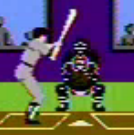 | 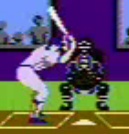 | 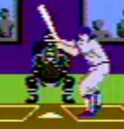 |
Field
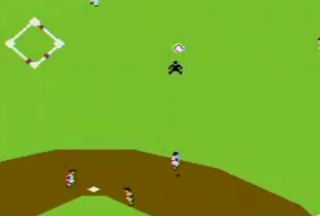
Right from the start I should mention that while the NES was not the most powerful machine out there in 1987, what it have was a dedicated set of code for screen scrolling. Scrolling on the NES is very smooth compared to other systems. With this added ability, Bases Loaded naturally becomes one of the first baseball games to invoke scrolling during the play. We are now at a time where the camera doesn't have to be zoomed out to show the entire field and all fielders on the screen at the same time. When the ball is hit the camera follows the ball and the field scrolls behind it. Playing the game this way has its advantages and disadvantages. One of the disadvantages is when the ball is hit towards the outfield your fielder is not always visible on the screen and you don't really know what direction you should move to collect or catch the ball. The advantage to this approach is when you throw the ball from the outfield to the infield or when the ball hits out to the outfield the screen smoothly follows the ball and doesn't require change of the camera view which might get disorientated users for a critical split second. As far as concepts of the field that is new to video games, we now have the on deck circle and the base coach areas along 1st and 3rd base.
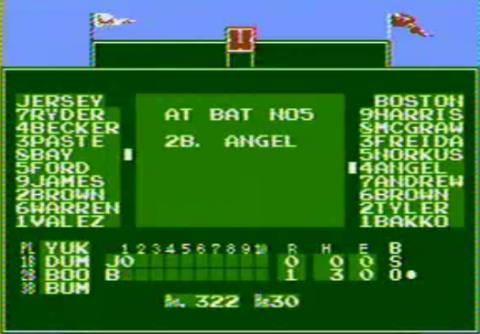
The scoreboard is something we are starting to see improved with each game. We have gone from not having any at all to animations in the jumbotron like we see in real ball parks in the 80's. The scoreboard provides more information. It now displays the lineup of teams as well as the current batter's average as well as number of home runs. The scoreboard includes a unique feature I haven't seen before and the initials of all the umpires. The flags on top of the scoreboard did not wave in the air and are static. The cut scenes on the scoreboard occurred during homeruns, pitch hitting and bringing in a relief pitcher. Calling another pitcher was my favorite since this was during the time when a golf cart actually went on the field and dropped off the pitcher... I love the 80's.
Fans
The crowds in this game are slightly disappointing. They are shown during the game but very boring and dull. The one thing that does exist though is there are fans displayed during the pitcher/battle duel. They are individual people but a solid grey and they are not animated.
Home Run Celebration
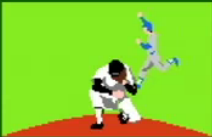
Hands down the best home run celebration to date exists in this game. As soon as the ball hits the stands, the camera moves to the scoreboard with the big letters "Home Run" then the scoreboard is zoomed in and takes up the entire screen where a video of the pitcher is shown kneeling down in disgust as the base runner is shown running behind him pumping his fists in the air. If there are other base runners during a home run they don't leave for the dugout after touching home plate but rather stay on the field and provides high fives.
Camera/Screen
I already mentioned it but shouldn't be forgotten this game's camera work is one of the kind. Never before has the camera actually followed the ball like it does in this game. In previous games the camera was static; everything had to be seen in one camera angle, which is why bird's eye view was the most popular way to show all the action. This game helped introduced the behind the pitcher camera during pitches. The scoreboard camera provided the user all the game info including rosters, current batters and menus for managers such as selecting a new pitcher. While the moving camera was not perfect, it is a start and great innovation for the industry.
Sounds
The sound chip in the NES is pretty impressive and we have heard some great melodies from previous games such as Super Mario but none of the sports games are that memorable including this game. The melodies in the game are nice and quick. They occur during the home run, every half inning and whenever there is a pause of the game. One of the small addition to the sound of the game that I enjoyed was when you pause the game you can hear the umpire call time. The umpire's voice is clear and doesn't sound like a robot as previous games sounded.
Gameplay - Modes
There are only two modes in this game; Pennant and vs. Mode. The first option is only for single players in which you try to play an 80 game season with your team. After each game you are given a password so you can continue the season at a later date. In the 80's I managed to complete the entire season which was a video game memory I will never forget. This concept of playing an entire season was amazing for its time and something that I always look for to this day when I play any baseball game.
Gameplay - Defense
Standard controls for the defense side of the ball. With the scrolling of the field it does make it hard to know where your fielder is sometimes but in general if you don't touch the controller the CPU moves your fielder towards the ball anyways. I find that this helps a great deal once the ball is in the air. Instead of just throwing to a base with the other button you can now run to a base. This helps with when you catch someone stealing. The pitching is standard as well, with the d-pad you select the type of pitch. You can change pitchers at any time. I found the ball to move more natural than previous games. It doesn't appear to float into the fielder’s glove as well as it travels faster than the base runners as it should
Gameplay - Offense
I might be incorrect but I believe this was is the first game in this blog series where I feel I have control over the direction of the bat as I swing. I cannot move the batter in the batter box but I feel using the d-pad I can hit an high and tight pitch as well as a low golf type swing. When you have base runners you do have control over which runner you want advance. At any time you can select to pitch hit. The batter's avg and home run count appear to matter in the game, as there are power hitters and non-power hitters.
Rules of Baseball
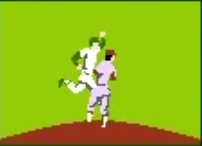
The greatest thing about this game is the fact when the pitcher hits the batter not only do you get to go to first base but there is a chance the batter will charge the mound and a good old fashion brawl will occur which you can follow on the jumbotron. After the fight is over you are forced to select a pinch-runner for the batter has been ejected from the game. If this isn't the best aspect of baseball to be incorporated in a video game I don't know what is. I also like the umpire movements behind the plate and on the field.
We can pitch-hit, pitch-run, change pitchers but that is all we can do regarding game management. We do have a line up but currently have yet been able to manage the line up before the games. We can however select a pitcher which the only pitching stat we can go by is ERA.
Video Game Innovations
- Charging the mound after being hit by the pitch
- Umpire calling 'time' when you pause the game
- Cut scenes during manager choices such as pitch-hiting and changing pitchers
- Camera follows the ball and the field scrolls
- Single player 80 game season mode
- Password system to manage season
- Numbers on uniforms
This is a series of blogs based on my own personal game collection. I will attempt to go through them in a chronological order according to their release date. I will also attempt to play then on their original platform using the original controllers the game was designed for. If I am unable to get the system or the game working then I will use PC emulation or another platform emulation like the Intellivision Lives! game for the gamecube
Previous entries
| 5. Microvision's Baseball (1980) 6. Atari 2600's RealSports Baseball (1982) 7. Nintendo's Baseball (1983) |
Great Baseball for Sega's Master System (1987)
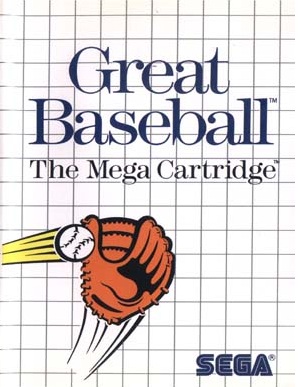
In 1983, Intellivision released one last baseball game, World Series Baseball, before the video game crash and the end of the Intellivision system. The game was a graphic milestone with picture in picture and camera views much like how the sport is shown on TV as well as play by play voice work. You can only buy the game via mail order and hard to find these days. Colecovision also released a baseball game towards the end of the system's life, Super Action Baseball, in 1983 as well. Like Intellivision's World Series Baseball the graphics was ahead of the time but the game was doomed because it required Coleco's Super Action controllers which were not very popular and not included with the system. After the video game crash, the country wanted to play baseball video games again, in 1987 Sega pleased the masses and released Great Baseball. There is a theory out there that any game that includes the words 'Great' in the title is anything but. Does this game break the curse? Let's play ball!.
Graphics
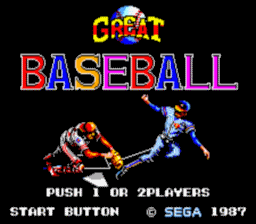
From the start you can tell that this game is going to be enjoyable to look at based on the title screen alone. The title screen contains a nice rendering of a base runner about to get tagged out at home. We begin to truly see 8-bit graphics and what they could look like . When you start the game a detailed view of pitcher, batter, and umpire are displayed. The game info is located at the bottom of the screen in an organized fashion and readable. The text is simple white on a solid black background. To help the user see the base runners, a bird's eye view of the field is also displayed in a picture in picture format.
Players
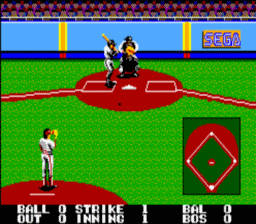
I have a confession to make; I love 80's sports fashion. I love baseball's stirrups, colors and stripes of the 80's. This game renders this 80's style of the uniform pretty good. This advancement in player graphics is due to the change of focus and ability to show different views of the game. Now we can zoom in on the pitcher and the batter during pitches. The pitcher/batter combo easily takes up majority of the screen. When the ball is hit the camera zooms out and we get the typical overview of the entire field and the player size is reduced as well as the details of their uniforms. The animations have really advanced as well. The swing of the bat and pitch are really smooth. We get to see the pitcher kick his leg out like how you pitch a baseball in real life.
Field
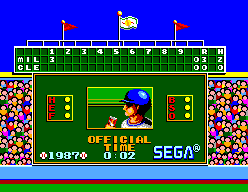
The field and stadium in general remind me a lot like Nintendo's first Baseball game for the NES. It is slightly more detailed and wider. The scoreboard is in the center, the shape of the outfield wall is the same. Both have batter boxes, scoreboard, and foul poles. The scoreboard during the play includes initials of each team, summary of each inning as well as total runs and hits. The Nintendo game did not include hits. This wasn't the only advancement of the scoreboard in Great Base however, between innings the scoreboard is takes up the entire screen and is more detailed and pretty impressive. For the first time we get to see a small video clip of baseball players as it would be displayed on a jumbotron. The animation was not of an FMV quality, more of a cartoon look to it. This expanded view we see a running game time, current count and flags waving in the air. The animations cycle through 3-4 different ones at random.
| Sega's 'Great Baseball' (1987) | Nintendo's 'Baseball' (193) |
|---|---|
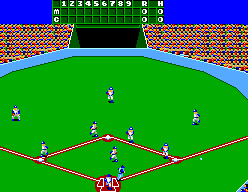 | 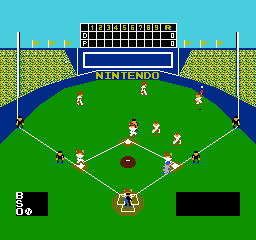 |
Fans
The crowd is displayed and also more detailed then NES's Baseball. I can tell that the crowd is still nothing more then a repeated pattern but when they get excited during a big play they have more animations besides a rapid change of color. During the scoreboard view, the crowd is even further detail and we begin to see individual people in the stands.
Home Run Celebration
When I first witnessed the jumbotron in this game, I couldn't wait to see how they incorporate it during home runs. I was left pretty disappointed; the jumbotron isn't even used, there is no cool animation shown and feel like it was a huge mistake not to include it. Sure the crowd goes nuts and moves around and the words 'Home Run' appears below in the scoreboard in outfield view but that is about it. It does have a nice melody to help with the celebration.
Camera/Screen
There are four different cameras and different views during the actual gameplay and two additional screens for the information. During the pitch, the camera is positioned behind the pitcher when you pitch as well as hit. Once the ball is hit a bird's eye view of the outfield is displayed that contains the entire field, outfield wall, pitcher’s mound. If a fielder throws to a base, the screen is switched to an infield top-down perspective.
| Behind the Pitcher view | Bird's eye view | Top down view |
|---|---|---|
 |  | 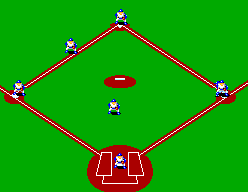 |
Sound
The lack of jumbotron during the home run celebration disappointed me first; a close second was the sound or the lack of sound. I am disappointed mostly because we are now in 1987 and we still have to play baseball in silence. Yes there are melodies before each half inning and during home runs as well as the title screen but that is it. Besides the sound effects and the umpire calling the plays there is nothing else. The sound effect of a strike or a base hit is also really bad, it sounds like my cartridge is busted but it's not. The umpire does speak and has a clear voice but that is the only positive thing I can take away from this game
Gameplay - Modes
There are a grand total of 6 different game modes in this game. With technology advancing, developers are started to add different modes that use the same graphics.
- 1 player - Level 1 : one player single baseball game, fielders automatically go after the ball.
- 1 player - Level 2: one player single baseball game, fielders are controlled by the gamer. The fielders who are closest to the ball
- 2 player - Level 1: two player single baseball game, fielders automatically go after the ball.
- 2 player - Level 2: two player single baseball game, fielders are controlled by the gamer. The fielders who are closest to the ball
- Home Run Content 1 player. Try to hit as many home runs in 20 pitches
- Home Run Contest 2 player. Try to hit as many home runs in 20 pitches each , 2 players alternate swinging after each pitch
Gameplay - Defense
Pun intended when I say the defense in this game isn't great. I had such a hard time controlling the fielders that I switched to level 1. The fielders were running in slow motion and infield home runs were common when I was playing in Level 2 mode. Pitching in this view was a nice change of pace, It was different and because you see the ball hit the glove I had a greater sense of control. As pare for the course these days, the direction of the d-pad controls the pitch type; Up for a fast ball; Left for a left curve; Down for a Change-up. One of the advancements of pitching in video games we are introduced here is the concept of specialty ball and the ability to select a pitcher and stamina. The specialty balls you can select is fastball, slowball, slider, and knuckleball. Finally we can pitch like Tim Wakefield. Regarding controlling the fielder after they collect the ball, standard practice here as well. Press the direction of the base you want to throw to. You can fake a throw by pressing button 1 instead of button 2.
Gameplay - Offense
The offense is par for the course as well. The ability to pitch hit is the biggest innovation on the offensive side of the ball. To bunt the ball is more natural for you just stop pressing the swing button and don't follow through. You do have ability to control any base runner by selecting the base with the direction pad and press button 1. We also have the ability to move the batter around in the box.
Rules of Baseball
I was ready to list all the great things this game includes regarding the sport until I read the last sentence in the manual regarding ties after the 9th inning. "In a 1-player game: The computer wins" What!! Why in the world would they program it this way? In 2 player mode it goes to extra-innings. Baseball never ends in a tie.
Now the positive side; One of the great things this game introduces us to is not more complex rules of baseball but a different aspect of the sport, game management. Here is the first time we begin to see the split between simulation baseball video games and arcade style of the gameplay. We now have control of not just the players on the field but also become the manager of the team. We are able to pitch hit as well a put in a relief pitcher. These rudimentary simple options greatly expand the strategy of the sport. Before each batter, your roster is displayed showing the batting average, number of hits and left or right handed. One thing this game doesn't include is their defensive stats. The game does place a limit of the number pitch hitters during the game.
Video Game Innovations
- Complete list of baseball teams with two leagues (A and N) . During the selection of team a map of the US is displayed.
- Select different pitchers, special pitch and stamina
- Picture-in-picture during the behind the pitcher camera
- Crowd animated during home run
- Jumbotron displayed with animations.
- Crowd more individual appearance
- Complete roster with names and stats
This is a series of blogs based on my own personal game collection. I will attempt to go through them in a chronological order according to their release date. I will also attempt to play then on their original platform using the original controllers the game was designed for. If I am unable to get the system or the game working then I will use PC emulation or another platform emulation like the Intellivision Lives! game for the gamecube
Previous entries
| 5. Microvision's Baseball (1980) 6. Atari 2600's RealSports Baseball (1982) 7. Nintendo's Baseball (1983) |
World Championship Baseball for Intellivision (1983)
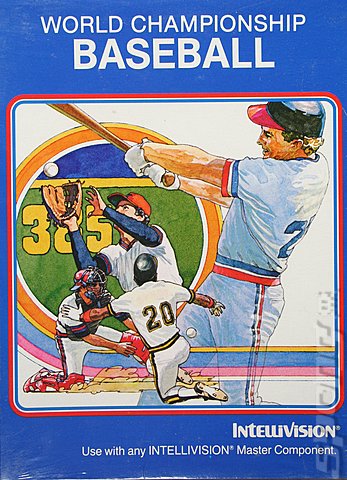
In my RealSports Baseball entry, I mentioned the bitter rivalry between Intellivision and Atari. One of the aspects of this rivalry centers around the sport genre. Between 1980 and 1982, Intellivision managed to expand their cartridges from 4k to 8k. With this increase size, the Intellivision developers decided to take their existing sports line up and expand it by adding new features to reduce cost of developing an entire new game from scratch. Sounds familiar right? Next time you see the next Madden or Call of Duty you have Intellivision to thank for this new business practice. Because this is more of a retooling of an existing game, this entry will be shorter. Please refer to Intellivision's Major League Baseball entry for more in depth look at this game. I don't own the actual cart of this game but instead part of the Intellivision Lives! disc for the gamecube.
Graphics
The graphics are not too different from the previous game. The field is a little different and more defined. The on screen text is different as well, Out,Inning,Strike and Ball stats are positioned the same; but the score is different. The previous game included labels for each team; "HOME" and "VSTR" but now they are removed. This game adds more animation and there is a border around the game that helps sell the concept of the field.
Players
Overall the players look exactly the same, except for more advanced animation. This animation is where this game truly shines. For the first time the runner over runs first base like how you are taught to do in little league all the way up to the pros. The base runners now can slide in to the base and this sliding animations includes dust spraying around the runner. This mind-blowing animation reminds me of Pig Pen from the Peanut cartoons. The slide into base appears to be more of a graphical advancement as it doesn't actually help you avoid a tag.
Field
| Major League Baseball (1980) | World Championship Baseball (1983) |
|---|---|
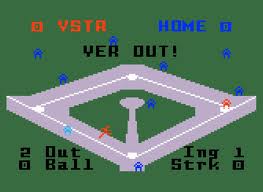 | 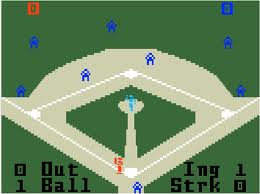 |
As you can see from the images above, The field is more realistic and more in tune to how MLB fields were shaped in the early 80's. Gone are the color of concrete for the baseball diamond, replaced with the color of dirt.
Fans
Nothing has changed regarding the fans from the previous version
Home Run Celebration
Nothing has changed regarding the home run celebration from the previous version
Camera/Screen
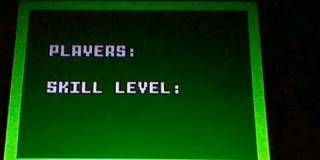
Nothing has changed regarding the camera and screen from the previous version. There is however an extra setup screen that lets you enter the number of players and the skill level.
Sound
The sound doesn't appear to change from the Major League Baseball game this game is based on.
Gameplay Modes
Now we can see where the extra 4k of memory went with this game. The extra 4k went to making the previous game now one player. We can now play baseball on the Intellivision alone. Along with the benefit of either playing one or two players, the skill level option has been retained from the previous version.
Gameplay - Defense
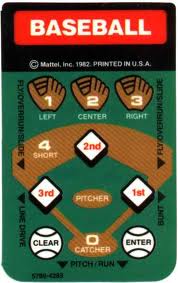
Once again in Intellivision fashion we have a controller overlay that is used to help control the action on the field. With the addition of fly balls and grounders the ability to run and then throw the ball is very important and the controller lets the gamer do just that. The pitching remains the same; you move the joystick in the direction of the pitch type you want to pitch.
Gameplay - Offense
I mentioned it before. One of the advances of baseball video games is the ability to produce a pop fly. With this advancement comes the requirement of having to control that. This is handled by the batter. The player is now able to select to hit a grounder, line up or pop fly based on the button on the keypad you press for your swing.
Rules of Baseball
With all these advancements in baseball video games we seeevery year, we have to go through the rules and baseball traditions with a finer tooth comb. While we now have sliding base runners and hitters running through first base, we should expect a more finer controlled tagging system and catching a runner between the bases. The controllers still don't provide the gamer with fast switching between fielders and the throwing animations is very stiff.
We still don't have a game that requires baseball strategy in terms of roster management. There is no difference between top of the order or bottom of the order. The pitcher is just as strong in the first inning as he is in the ninth.
Video Game Innovations
- Ball travels in the air, complete with shadow
- Sliding base running
- Base runners through the first base
This is a series of blogs based on my own personal game collection. I will attempt to go through them in a chronological order according to their release date. I will also attempt to play then on their original platform using the original controllers the game was designed for. If I am unable to get the system or the game working then I will use PC emulation or another platform emulation like the Intellivision Lives! game for the gamecube
Previous entries
| 5. Microvision's Baseball (1980) |
RealSports Baseball for Atari 2600 (1982)
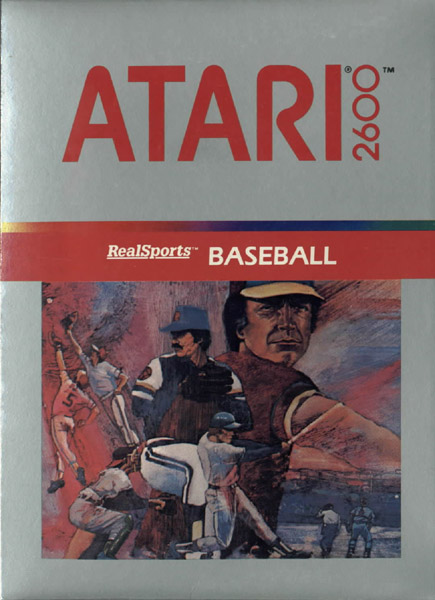
The year is 1982, one year before the 'Video game crash of 1983'. In 1980 Intellivision beat up on Atari's earlier baseball game, Home Run (1978), by including screenshot of Home Run next to newest 'Major League Baseball' game both in printed and video media. It reminds me of the Sega's "Nintendon't" ad campaign. Atari had to fight back thus they created a new line of sport games, 'RealSports' in the early 80's. Atari finally completed development and released RealSports Baseball for the 2600 in 1982. Two years after Intellivision's Major League Baseball. Sadly I do not own a cartridge of this game only the Xbox emulation of the game via GameRoom, so I will base this blog on this version. Does Atari successfully retaliate and one up Intellivision's baseball? Let’s find out
Graphics
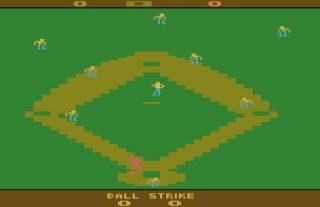
Umm....well It is an improvement over their first entry, Home Run, but it's enough to derail Intellivision's aggressive ad campaign. Atari managed to successfully put 9 players out on the field so I give them points for that and some minor points for displaying a baseball diamond but we are in 1982 and those things are really standard now. The biggest improvement Atari did do in terms of graphics is the text. The text in the game is easy to read and understand. I like how they created a separate box for the on screen text and game info. Previous games including Intellivision's, all the text were huge and printed right on the field with the green background behind it.
Players
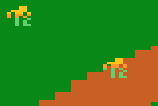
The players are more defined then Home Run's rendering but equal to that of Intellivision's player model. We do not have baseball hats in this game which is a little sad since Home Run was one of the first to pull that off. This game the players all look the same based on their general role in the game. All fielders look the same, the pitcher is different as well as the batter. The batter does swing his body when you attempt to hit the ball. The pitcher also has a quick animation for its windup.
Field
| Atari's RealSports Baseball (1982) | Intellivision's Major League Baseball (1980) |
|---|---|
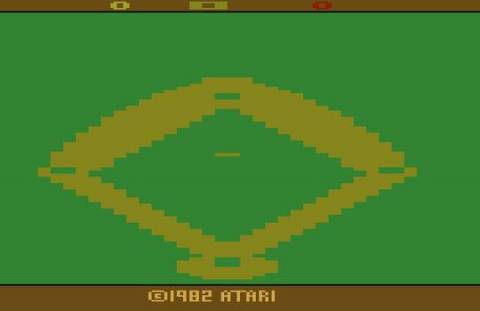 |  |
Wow we have a baseball field, oh what a dirty ugly field it is. I don't think I have seen so many jagged lines in a video game before. Just compare the two games and you see how weak the Atari was in rendering diagonal lines. This game doesn't really advance the field in any way. The colors are also dull, It does render the diamond in the correct dirt brown color, unlike the Intellivision's concrete look. The bases are just small lines including the pitcher's mound. The one nice thing is that because the on screen text is separate from the field we get a full view of the field and the players.
Fans
It is 1982 and we still don't have any sort of crowd or fans displayed during the game.
Home Run Celebration
When you hit a home run, the words 'HOME RUN' appear in the bottom line of text and there is some sort of noise coming from the machine. This game does provide one of the first of its kind regarding home runs. In this game because you have to control the base runner after every hit, it doesn't make an exception for home runs. When you hit a home run you have to manually run around and touch all the bases yourself before the next pitch can be thrown. This might be fun while playing against another player for you can walk around the bases if you want. You can get up and make a ham sandwich, come back and finish your celebration in style.
Camera/Screen
There is only one camera angle used in this game. The angle of the gameplay is less bird's eye view and more behind the plate in the nose bleed seats. This is a standard view for baseball games in the early 80's.
Sound
You should be happy this blog is unable to produce the sounds that this game produces. It has sound for the hit, and a little beep when a ball lands in the glove of a fielder. The sound would be good if they just didn't have the noise for the strikes. Strikes produce this low pitch noise that feels like I just broke something. There is no background music.
Gameplay - Modes
Like any good Atari game, there are multiple game modes. This game has 4 modes, 2 modes for a two player game and 2 modes for a one player game. All modes deal with a single baseball game.
- Game 1: 2 player game, Player 1 starts in the outfield, Player 2 starts at bat. Batter can hit every pitch.
- Game 2: 2 player game, Player 1 starts at bat, Player 2 starts in the outfield, Batter cannot hit balls.
- Game 3: 1 player game, Player starts in the outfield, Batter cannot hit balls.
- Game 4: 1 player game, Player starts at bat, Batter cannot hit balls.
I know you probably wondering about the fact that batters can or can not hit balls is all about. Trust me it is a weird concept and I will explain it more in the Gameplay section.
Gameplay - Defense
I will give this game a pass when it comes to defense. The Atari is limited by the controller; there is just not much you can do with a joystick and one button. You can get away with it in space shooters or games where you only control one object or thing on the screen. With baseball you control a entire team, you control 9 different objects that are on the screen at any given time. Atari developers have to be more creative in coming up with ways to pass this control to the gamer in a way that doesn't hurt the gameplay. This game is does have a learning curve to it, the control is not as natural as it seems. Lets start with pitching.
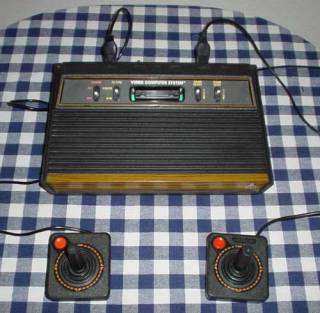
Instead of just pitching using the button and the joystick to control the curve of the ball, this game has predefined pitch types that you select by pointing the joystick in a direction; down for fastball, down for intentional ball...etc Once you make your selection you hold the button down and flick the joystick down towards the batter. The confusing part of the pitch is that every pitch looks exactly the same. Every pitch from a visual prospective is thrown directly in the center of the plate. There are no visual clues if you selected the correct pitch. Each pitch has a random variable of it produces a strike or a ball, except the 'intentional ball'. The fielding also takes some time to get use to. Once you collect the ball you are free to run around with the ball in hand or throw it to a base; up for second base, down for home plate. It takes some getting use to because the fielder throws the ball not to the base itself but towards the fielder that is covering the base which never stands on the base so you have to do some additional running.
Gameplay - Offense

We have ultimate control of the base runners, including stealing a base. To steal a base first we have to tell the CPU that was want to control the base runner by pressing the button and the direction of the base. After this is done the base runner is highlighted, moving the joystick to the right advances the runner. This is a creative way to add more control to the gamer but the highlighting the base runner more or less tips off the other player that you are about to steal. To hit the ball you can attempt to call your shot but moving the joystick in a certain position as you swing; up for long fly ball; down for bunt. I found that it didn't work 100% of the time and not sure if that was by design or just the case of bad controls. In truth we are all not Babe Ruth and maybe this game forces us to eat humble pie.
Rules of Baseball
This game is a great example of evolution of developers doing more with less and learning from the past. This game runs on the same system as Home Run. The technology didn't improve but yet we now have 9 players on the field, we have an actual field. we have complex baseball concepts such as throwing, base stealing, double plays. There isn't much this game doesn't have in terms of pure baseball, it just doesn't do anything new to video game baseball
Video Game Innovations
- Attempt at colorful uniforms
- complete control of all base runners
- control of direction of a base hit
- control of home run walk around the bases
This is a series of blogs based on my own personal game collection. I will attempt to go through them in a chronological order according to their release date. I will also attempt to play then on their original platform using the original controllers the game was designed for. If I am unable to get the system or the game working then I will use PC emulation or another platform emulation like the Intellivision Lives! game for the gamecube
Previous entries
| 5. Microvision's Baseball (1980) 6. Atari 2600's RealSports Baseball (1982) |
Baseball for Nintendo Entertainment System (1983)
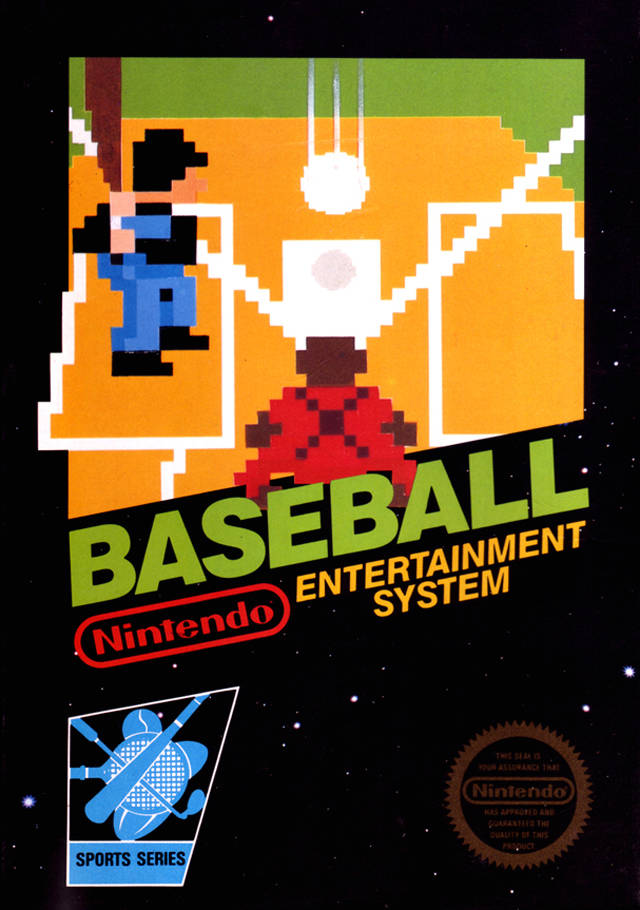
I should probably start this entry by pointing out that 1983 is the one of the first years that gamers receive multiple baseball games at the same time. It seems like every system had a new baseball game. In my personal opinion I don't think it was Atari's E.T that lead to the video game crash of 1983,but the fact there were too many baseball games. With release dates not being 100% accurate back then, It is hard to say which game advanced an aspect of the game first. I don't have all these baseball games, so they won't all be part of these blog series.I have done far amount of research on all of them, I just can't write about the game until I actually play them.
This entry is going in depth with Baseball for the NES. Even though the US didn't get the game until 1985, I am considering it a 1983 game because that is when the international gaming community could play it. Other baseball games in 1983 include Intellivision's World Series Baseball, Realsports Baseball for Atari 2600, 5200 and 7800, Colecovision's first baseball game, Super Action Baseball and the first baseball management game, Micro League Baseball for the C64.
Back to the game at hand, I cleaned my Baseball cartridge, blew the dust off the connectors and turned on my NES system that I always manage to have near my TV since I was a kid. My RF adapter I have been using for the previous games is not in the best shape so I was glad to plug in my composite cables into the NES and get a cleaner look. Baseball never looked so bright.
Graphics
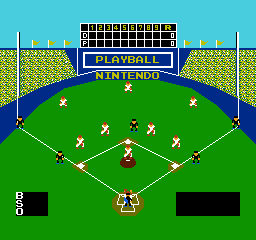
This game advances the graphics of a baseball game by at least double. It laid the ground work for majority of the future games. We see umpires signaling the plays, baseball uniforms, team names, crowds and different camera angles during the game. This is the first time we see a full scoreboard with a summary of scores per inning as well as the overall total. The current inning and batter's count are basic but readable. It uses a baseball icon to display the counts and the tally of balls, strikes and outs. On the bottom right displays the umpires call; "Ball", "Strike", "Out" and "Safe". I find the text very easy to read for a couple reasons. The box where the text is displayed has a black background, which makes the white text stand out and more defined. Previous baseball games, the text were displayed directly on the green field and the colors tended to blur. Also the use of icons helped liven up boring text.
Players
A baseball game with uniforms? This game has it all. The players from a graphic standpoint are improved. Each fielder, batter, pitcher has more than one color. Each team appears to have two assigned colors to them. Yes I said teams. First baseball game to put the power of selecting a team in the hands of the gamer. From a game play prospective there doesn't appear to be any difference between the teams. There is no sense of player roster, all batters look the same, the only difference between the various teams is what two colors make up their uniform. The animation of the batter and pitcher is where majority of the work was done. When the pitcher winds up you can actually see him calling off certain pitches, you get a sense like he agrees or disagrees with your pitch selection directly. The batter takes a full swing and you can move the batter around in the batter's box. The fielders on the other hand are sort of dull. Sure they have various poses for certain actions. We have the hand in the air to catch the ball for an out, we have the throwing pose to the various bases, but it just seems dull. It might be due to the slow nature of the game play but they don't seem to run very fast out there in the outfield.
Field

Each entry of this blog series we continue to see more and more baseball elements being incorporated into the game. Intellivision's Major League Baseball incorporated outfield walls (which were weirdly invisible). After Astrocade's Tornado Baseball, foul lines and the correct shape of the bases and home plate are now considered par for the course. Additional element of the sport that makes it's introduction into the video game world is the batter's box. The batter's box is not just a graphical element but also improved the game play and gave the gamer more offensive control. We can now move the batter anywhere within the batter's box. My style of game play I move my batter to the top and slightly away from the plate, I feel I have better contact with the ball that way. Along with the field improvements we are also beginning to witness the formation of a ball park around the playing field. We have a ball park scoreboard, pennants waving in the wind at the top of the stadium as well as foul poles extending the foul lines painted on the field itself. I just want to also point out a standard rule in terms of actual baseball outfield walls. An an outfield wall is not complete unless it contains an advertisement. Thankfully Nintendo knew this and decided to add their name on the wall for advertisement.
Fans

Usually the speed of light is faster than sound but in terms of baseball crowds, it's just the opposite. We heard the roar of the crowd in games like Tornado Baseball and Major League Baseball for the Intellivision in the late 1970's but were never able to witness them. This game introduces us to graphical sports’ crowd. To be honest, there isn't much to see, it is just a pattern of different color dots. This pattern would only be slightly more advanced in the later years and personally feel they actually don't get much better. This aspect of the baseball video game will always lack in terms of quality.
Home Run Celebration
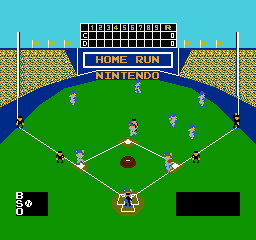
With the innovation of fans and visible crowds in the park, it is only natural that they are used for the home run celebrations. As you view the ball fly high into the seats. The crowd rotates between many different colors given it a strobe light effect to it. As well as the scoreboard flash the words 'HOME RUN'. This game also includes it's own melody for home runs. What I enjoy about these home runs is the buildup. Because the game play is so slow, it takes the ball a good 3 seconds to reach the stands, you see it going, going gone almost in slow motion. You can look at the field and the outfielder continues to run against the wall with their glove out just in case.
Camera/Screen
I briefly mentioned it before but this game is one the first to utilize multiple camera angles for game play. When the pitcher is pitching, the game displays a zoomed in look in the infield. When the ball travels out from this view, the game switches to a more zoomed out look where you can view the entire outfield as well as all this bases. Up until this point, all baseball games only had this view. This provided a more detailed, smoother look during the pitch. Both views displayed the count and the umpire call. The infield view displayed the current score and inning indicator; outfield view displayed the full scoring summary per inning. This game also added an element of ground balls and balls travelling in the air. As the ball traveled higher in the air, the shape of the ball grew and created a shadow on the ground. The shadow helped the gamer know where the ball is travelling and will land and the size of the ball helped the gamer know the vertical distance and therefore time until it comes back to earth.
| Outfield View | Infield view |
|---|---|
 | 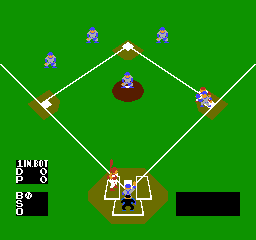 |
Sound
The sound was just OK. The title screen had a little melody but this melody was recycled from previous Nintendo sports games of the time. Home runs had their own melody and each time the ball traveled it created a slide whistle effect. There was no background music so overall the game was on the quiet side of things.
Gameplay - Modes
There is only two modes. one player single game or two player single game. After the game ends, press the reset button and do it all again.
Gameplay - Defense
The graphics are a step in the right direction but the overall game play takes one step back. Overall the game is just slow. It takes forever to pitch the ball after you selected the pitch and the fielding is really bad and slow. For pitching using the d-pad you select the type of pitch, 'Up' for change up, 'Down' for fast ball'...etc and you press the A button to pitch. The pitchers animation is slow and after awhile I found myself attempting to speed it up by pressing the A button many times. Once the ball is in the air is where the game play really slows down. If the ball lands a couple inches away from the closest fielder, good luck trying to avoid a triple or inside the park home run. The gamer has zero control of the fielding besides telling it where to throw it after it retrieves the ball. The CPU fielders seem to be in a better position. The collision detection is really bad as well. Most games if the baseball touches any part of the fielder, they consider the ball to be caught. In this game you can stand right over the ball on the ground and it doesn't pick it up; the ball has to be directly in the center of the fielder. Once the fielder does have the ball, using the d-pad you select the base and able to throw the ball to that base. The problem I have with the throwing animation is the fact that the ball travels the same speed for every throw. If the center fielder throws to home, you might as well use this time for a bathroom break because it is going to be awhile.
Gameplay - Offense
The biggest game play improvement in the offense is the ability to move your batter within the batter's box. Using the d-pad prior and during the pitch you are able to move your batter to position yourself to get a solid hit. Also we are introduced to both left and right handed batters to add to the enjoyment and challenge of hitting the baseball. We do have full control of the base runners, not just the lead runner in prior games but all the base runners. I have always found this to be a challenge in baseball games, having the bases loaded cause me to panic for I know have to control 4 players at one time. Base running in this game is controlled using the d-pad and the B and A buttons. First you select the base runner then press 'A' to advance and/or 'B' to return. As we will see in later games, this never becomes standard and just about every game does it slightly different. For example some games you don't select the base the runner is on, you select the base you want a runner to go.
Rules of Baseball
Besides the slow gameplay, this game follows all the basic and advance rules and follows baseball traditions. I guess some can argue the slow gameplay is correct interpretation of the sport. We can steal bases, including home. The pitcher can pick off a player. We have umpires displayed performing all the signs correctly as much as their 8-bit arms allowed.
Video Game Innovations
- Crowds/Fans
- Multiple color uniforms
- Umpires visible
- Left & Right handed batters
- Different teams to select to play as
- Move the batter within a defined batter's box
- Stadium fixtures including foul poles and flags waving
- Scoreboard with a scoring summery per inning
- Multiple camera angles of the gameplay
- The speed of the pitch is displayed.
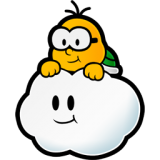
Log in to comment